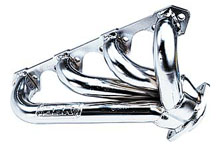You have no items in your shopping cart.
A Guide to Headers
Headers
Headers are great bolt on speed parts that deliver good bang for the buck performance. Making an engine flow exhaust better lets you pump more air and fuel through it, which will build horsepower. This is true as long as there are no bottle necks on the induction or exhaust side of the engine. Most headers are simple bolt up parts. It can take some time to install them, depending on the vehicle, but they're great additions to your exhaust system. Headers are one of the top performance parts added to vehicles.
Header Choices to Make:
 Material: Steel headers are usually the cheapest type available, but last the shortest amount of time. Stainless steel headers last much longer and they look great too. Stainless headers can turn blue/purple from heat, usually near the flange where the heat is the greatest. Ceramic coatings also last a long time and will look great under your hood. Ceramic coated headers can withstand temperatures much greater than stainless steel or steel. Depending on the type of ceramic coating, these headers can look new longer because they may not turn color like stainless headers can. Different manufacturers use their own proprietary coatings. Consult product specifications for durability and long term shine!
Material: Steel headers are usually the cheapest type available, but last the shortest amount of time. Stainless steel headers last much longer and they look great too. Stainless headers can turn blue/purple from heat, usually near the flange where the heat is the greatest. Ceramic coatings also last a long time and will look great under your hood. Ceramic coated headers can withstand temperatures much greater than stainless steel or steel. Depending on the type of ceramic coating, these headers can look new longer because they may not turn color like stainless headers can. Different manufacturers use their own proprietary coatings. Consult product specifications for durability and long term shine!
Primary Tube Size - The primary tubes are the individual pipes on a header that expel gasses for each cylinder to the collector. As mentioned above the length of these tubes is a tuning factor, but so is the diameter of the tubing. All header manufacturers will state primary tube size of each design and although it goes against common hot rod lore, bigger is not always better. These sizes will be stated in inch diameter. Typically a street car under 400 cubic inch will perform best with an 1 1/2" to 1 5/8" primary tube because the low RPM scavenging will offer higher torque production. For larger (400+ cubic inch) street car engines the best selection would be between 1" and 2" primary tube diameter. If selecting a header for a race car, typically 1" to 1 7/8" is used under 400 cubic inch. For race engines larger than 400 cubic inch engines, 2" to 2 1/4" is common practice. The main thing to remember is that a smaller primary tube will provide more low RPM air velocity for scavenging, thus more torque whereas a larger tube will provide more high RPM air velocity, thus more horsepower. The real art in selecting a header is to choose a design that is the least limiting for both low end torque and high RPM horsepower production.
"Stepped" Primary Tubes: - For some time now a few manufacturers have offered a "stepped header". This design involves using a mix of different pipe diameters on the primary tubes to get the best of both worlds. As mentioned above the goal is to find the header that offers the most for low and high RPM performance.The stepped primary design typically does offer more performance gains than a conventional single sized primary, especially for street cars.The only downfalls are that the fitment applications are limited and the price tag is typically higher since more labor is involved in their construction.
 Type: Headers come in different lengths. Depending on the engine compartment, you may choose one over the other. Equal length Long Tube headers typically perform better over the other types on street cars. If you car is equipped with oxygen sensors, you'll typically need to extend the wires because the sensors are at the end of a longer header than stock exhaust manifolds. Shorty headers are the compromise header. Shorty's are generally easier to install than long tubes, but don't usually perform as well. They are meant for tight engine compartments where crossmembers, linkage or other obstacles make long tube headers difficult to install.
Type: Headers come in different lengths. Depending on the engine compartment, you may choose one over the other. Equal length Long Tube headers typically perform better over the other types on street cars. If you car is equipped with oxygen sensors, you'll typically need to extend the wires because the sensors are at the end of a longer header than stock exhaust manifolds. Shorty headers are the compromise header. Shorty's are generally easier to install than long tubes, but don't usually perform as well. They are meant for tight engine compartments where crossmembers, linkage or other obstacles make long tube headers difficult to install.
Application Specific/Direct Fit, Universal or Custom Headers: Many of today's cars have application specific (direct fit) headers from several manufacturers available. Direct Fit headers are made for a particular vehicle so they install easily on the intended model. Sometimes the fit is tight, but they do fit. Application specific headers are available for a wide range of vehicles going back to popular muscle cars of the 50's and 60's. If you can't find application specific headers, contact Outlaws on 08 8240 9500 for help in finding a set that fits. Universal headers like block huggers are a one size fits all. They are made to fit an engine and then you'll run custom exhaust from there. You can also choose to build your own custom headers.
Header Bolts: You have options when choosing header bolts. They come in steel and stainless steel in different grades (strengths). Many times there isn't much room to get a socket on a hex head header bolt. Header tubes are sometimes very close. There are even header sets that you have to put the flange bolts in in a certain order to get all of the bolts in. The alternatives to a standard hex head are a compact head. A common compact header bolt is a 3/8. A standard 3/8 bolt would require a 9/16 socket. A 3/8 compact header bolt usually requires a 3/8 socket, much smaller in size. Yet another alternative is an internal hex or Allen head header bolt. These bolts are for really tight header flanges, or if you just like the internal hex drive look. There are also combination bolts where the outside is a compact socket style and the inside is a hex head. To prevent header bolts from loosening, some bolt manufacturers offer special header bolts that won't back out.
Engine & Header Mounting Flanges: A header mounting flange is a good indicator of the quality of a header. Up to a point, the thicker the header flange, the better. Keeping headers sealed at the exhaust ports is troublesome with a flimsy flange. The header flange will have bolt holes drilled to fit a particular engine or cylinder head. While we're talking about mounting headers, choose a good quality exhaust header gasket. Don't go cheap on this gasket as you'll pay for it as you replace lesser header gaskets time after time.

